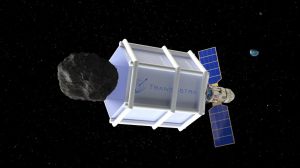ISRO hits escape velocity
After the last launch of the Polar Satellite Launch Vehicle (PSLV) in May, which carried two foreign satellites, it was understood that I...

After the last launch of the Polar Satellite Launch Vehicle (PSLV) in May, which carried two foreign satellites, it was understood that India was ready to enter the lucrative international satellite launch vehicle market. But the Indian Space Research Organisation (ISRO) intends to do better than just rent space on its launch vehicles. In a radical move, it plans to transfer the entire technology for manufacturing and launching PSLVs to the Indian entrepreneur.
Until now, all space-related technology has been the exclusive domain of the government. The role of local industry was limited to supplying some custom-made components to ISRO. But after the May launch, ISRO felt it was time for a paradigm shift. According to ISRO Chairman K. Kasturirangan, the PSLV vehicle has now been operationalised and the project matured to the extent that the whole technology can be transferred to industry. “ISRO will have to get out of the repetitive production cycle,” he says. According to him, the real challenge forISRO’s manpower lies in cutting-edge research and development. In fact, he believes that ISRO will be “at a dead end” if technologies are not transferred fast enough to industry. It should not be difficult for Indian industry to take up the challenge. Already, about 50 per cent of the components that go into a PSLV are manufactured by the local industry.
While ridding itself of the PSLV production line, the $1 billion space giant also wants to get out of the repeated manufacture of communication satellites. “The private sector really has to take over this activity,” says Kasturirangan. The world over, the manufacture and deployment of geostationary communications satellites have been taken over by large, profit-driven corporations. Kasturirangan feels that the technology for the production-line manufacture of the INSAT class of satellites can easily be absorbed by industry. It should be an attractive proposition because in the immediate future, space platforms will be the mainstay of thetelecommunications industry.
One Indian who is already looking at these millennium technologies is Subhash Chandra of Zee Television. Zee plans to design and launch a satellite of its own, which will be suited to the media needs of the subcontinent. India’s first private satellite, Agrani (Leader) will cater to the telephony market and will also have transponders carrying services like DTH (Direct to Home). The satellite could well be made locally if Zee so desires as India has the capacity to fabricate sophisticated comsats, ISRO scientists feel.
However, ISRO wants to continue to make custom-designed remote-sensing satellites which are unique and role-specific. Though industry is lapping up the images beamed down by Indian remote sensing satellites (the popular Eicher city maps are probably the most visible manifestation of the phenomenon) it is still too early for Indian industry to show an interest in making its own remote sensing satellites. ISRO also wants to continue to develop more sophisticatedlaunchers like the GSLV, capable of putting 2,000 kg satellites into orbit and, generally speaking, continue to meet the development needs of the country. ISRO wants to shape its future on the rather successful French model. In France, most of the research and development relating to space technology is conducted by the Centre National D’etudes Spatials (CNES) in Paris. Once a product has been adequately tested, it is transferred to Arianespace Corporation, a purely commercial arm. Araianespace then produces the components and launchers in bulk on a production line.
Talks have already begun with various industries and possibly, PSLV may be bought by a consortium of Indian industries. Godrej and Boyce, Larsen and Toubro and Walchandnagar Industries are already major suppliers of components and, most probably, one of them will come forward to head the consortium, say ISRO officals. Going a step further, the ISRO chairman says that sophisticated test facilities developed by ISRO at considerable expense can bevery easily shared with the private sector. He categorically emphasised that there was no need to build another launch-pad as the existing facilities can be shared by the private sector and the government.ISRO’s interests in the forthcoming consortium will be taken care of by its commercial arm, the Antrix Corporation, which is likely to have a shareholding in this move towards the privatisation of space technology in India. Antrix is already doing business worth Rs 40 crore a year, exporting high-quality space products to leading multinationals. If all goes well, the first industry-manufactured commercial launch of PSLV will take place early next year.
The 44-meter PSLV rocket weighs a whopping 294 tonnes, costs about Rs 70 crore and can carry loads up to 1,200 kg. Industry experts estimate it can very easily make a small beginning in the $60 billion international market for launchers.
After the last PSLV launch, Prime Minister Atal Behari Vajpayee had announced that many more foreign satellites would belaunched from Indian soil soon. But he had given no indication that the launch marked a whole new policy direction for the space industry.
The writer is India correspondent for Science’


- 01
- 02
- 03
- 04
- 05




























